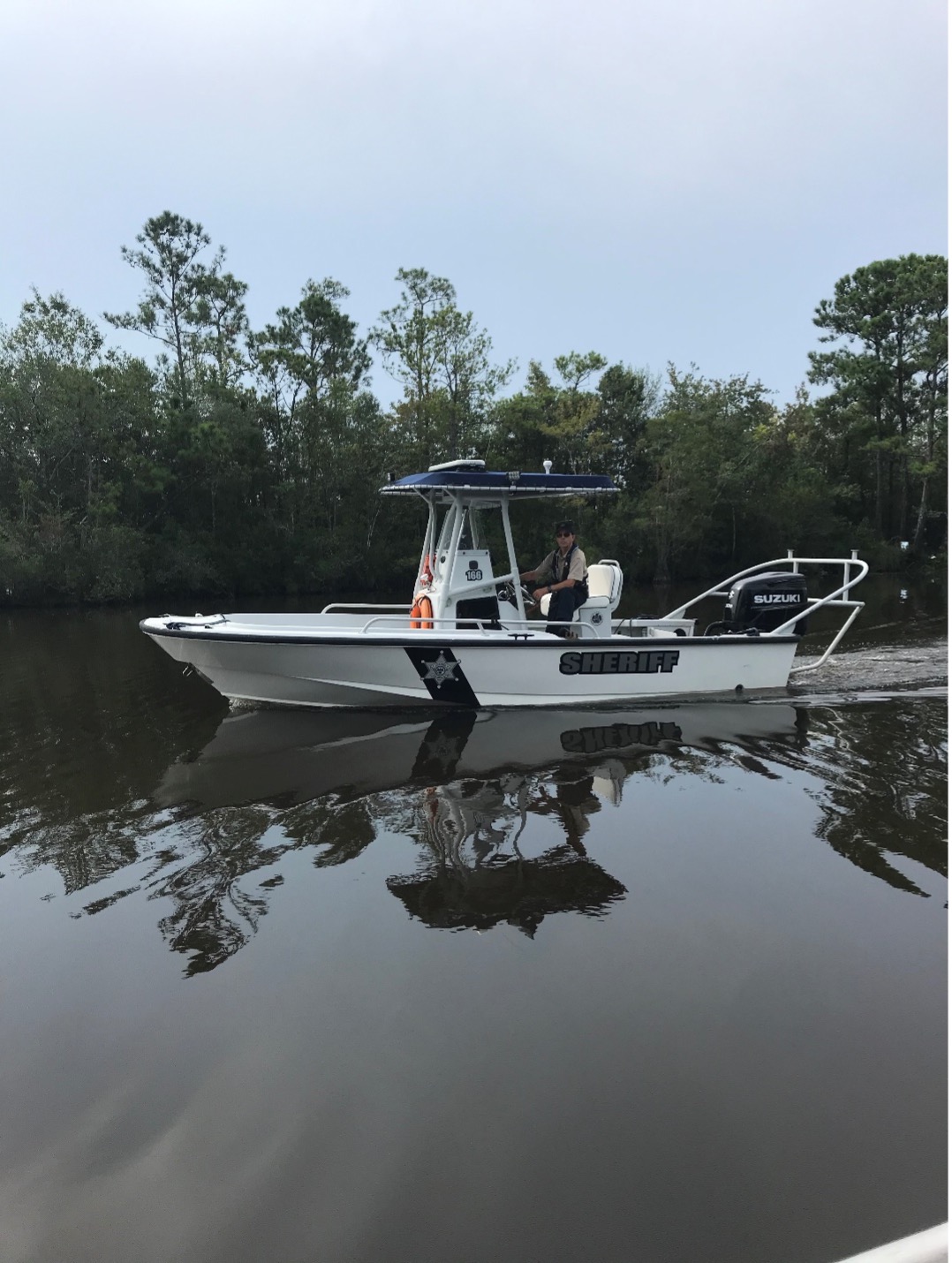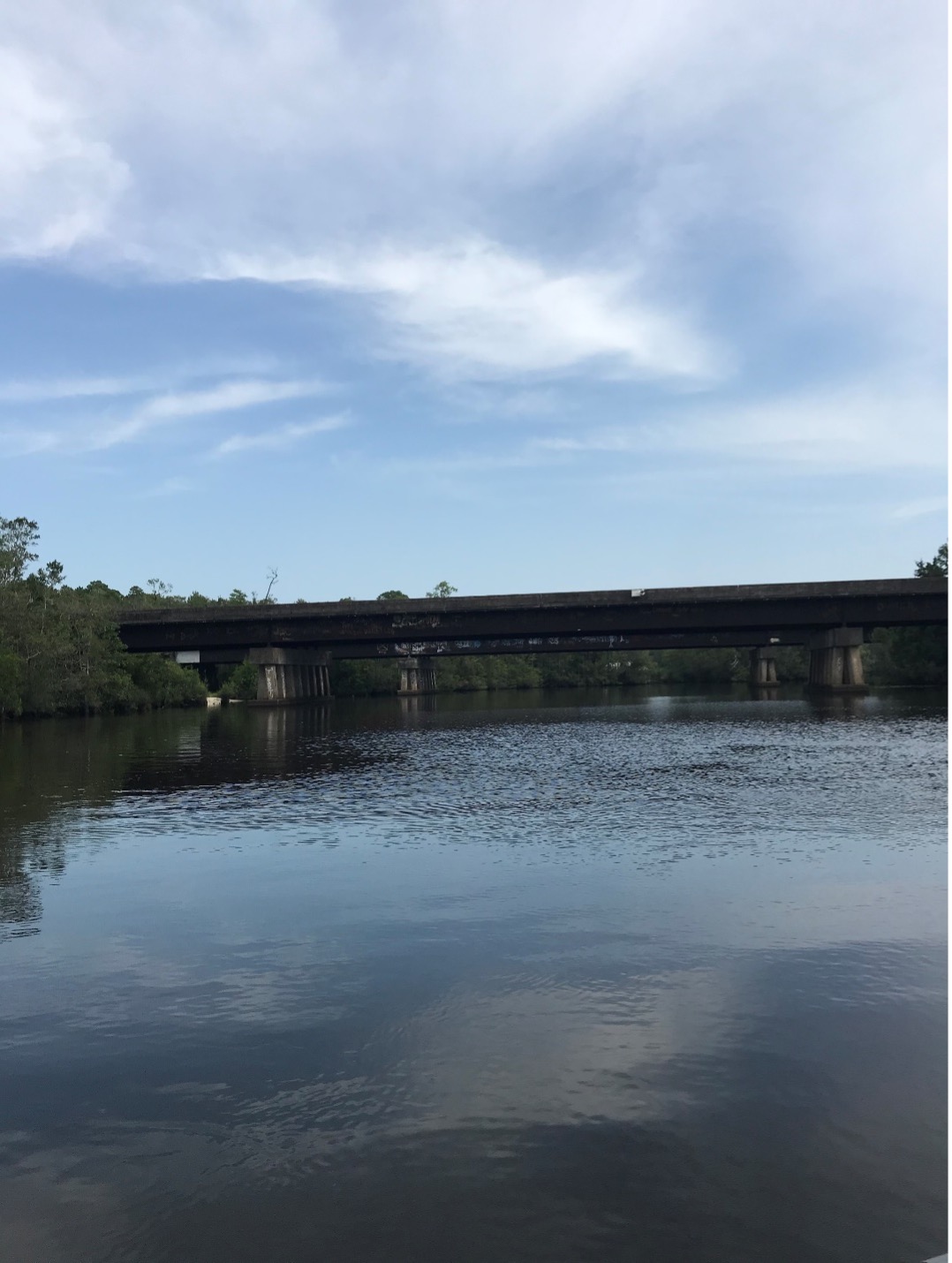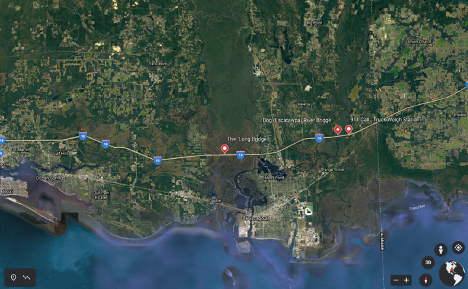A truck driver spots an adult’s body floating in a southern Mississippi river, wearing a blue and white checkered shirt next to an ice chest. Responding deputies make a discovery that will mark the start of several mysteries that will plague Jackson County for decades.
Episode Transcript
*Highway traffic and CB radio chatter*
Amanda Reno: It was cold and rainy on the night of December 3, 1982, in Southern Mississippi.
Semi-truck drivers driving on interstate 10 chirped over their CB radios filling the airwaves with their usual long-haul chatter.
One driver interrupted the friendly banter to report he’d seen something concerning.
He said he’d noticed a barefoot woman wearing a blue plaid shirt and jeans walking on the side of I-10.
She looked distressed, and most worrisome of all was that she was carrying a baby.
Reports would later indicate that several drivers had seen the mystery woman too and stopped to help or offer her a ride.
*Baby crying*
…but she refused and tucked her crying baby tighter into a blanket in her arms.
Greg Bodker: Two days later, on Sunday, December 5, 1982, as the sun rose over the horizon, a truck driver traveling east on I-10 between the Pascagoula River and Estatawpa River in Jackson County…made a desperate 911 call from a weigh station’s payphone.
*Dialing a payphone and dial tone*
Here are two voice actors recreating the call from information found in police reports.
Female Actor: Jackson County Sheriff’s office, what’s your emergency?
Male Actor: I was driving on I-10 towards Alabama over the long bridge at Hwy 613 I, I think I may have seen a body in the river
Female Actor: Can you be more specific about the location of the body, sir?
Male Actor: You know, down in the marsh, next to the bridge. I, I think it was hung up by the bridge pilings or something. It looked like it was wearing a blue checkered shirt, next to an ice chest.
Female Actor: What’s your name and location, sir?
Male Actor: Ted, I am at the truck scales on I-10.
Greg Bodker: Ted didn’t have to wait long for Jackson County authorities to respond to where he was.
*Siren blip*
At 6:53 am a reserve deputy named David Lawler, met Ted at the truck weigh scales.
Deputy Lawler had just started his shift, which normally would have been pretty quiet…but today wasn’t like other days…
He had no way of knowing that THIS call would be the start of a mystery that would last for nearly FOUR decades…
Amanda Reno: Welcome to Solvable, I’m Amanda Reno and I’ve been a genetic genealogist for 6 years.
In my career, I’ve spent a lot of time helping adoptees and those seeking information on their biological identity.
For the last 3 years, I’ve shifted to helping law enforcement identify John and Jane Does as well as determining the source of DNA found at crime scenes.
Greg Bodker: I’m Greg Bodker, a 26-year law enforcement veteran.
Amanda and I met while working on a cold case homicide in Ohio.
We used the strengths of our professions, law enforcement, and genetic genealogy, to solve that case and we knew that we could work together to solve other mysteries throughout the country.
Amanda Reno: I see cases through the lens of a genetic genealogist and researcher. I’ve always had a passion for giving names to those whose names have been taken from them.
Greg Bodker: and my extensive investigative and administrative background allows me to look at cases through the eyes of detectives and the people who run law enforcement organizations.
In this podcast, we’re going to take you on a journey to southern Mississippi, through a series of firsthand accounts of unsolved Jane and John Doe cases that span decades.
Amanda Reno: The first case we’re convinced IS solvable is the case of a baby found floating in the Estcatawpa River of southern Mississippi on a cold winter morning in early December 1982.
Her identity and how she got in the river has remained a mystery for 38 years.
Greg Bodker: This case has impacted individuals all over the world.
Dedicated law enforcement officials from Mississippi who are still involved in the case continue to seek answers and find justice.
Our investigation aims to generate new leads, with help of never before heard interviews from investigators who know the story better than anyone.
At the end of each episode, we’ll also have a segment called “The Missing Minute” which highlights other unsolved Doe cases in the Jackson County region.
But right now, let’s jump right in with where this story begins back in 1982.
When the truck driver recounted what he’d seen in the Pascagoula River while driving on Interstate 10 on December 5th, 1982, Jackson County sheriff’s deputy David Lawler took detailed notes and put a call out to other reserve deputies in the area to begin a search for an adult’s body in that waterway.
Ted told authorities that he’d seen the body floating in the river while he was driving east on the interstate’s Long Bridge looking out of his driver-side window.
The “Long Bridge”, Ted was referring to is a nearly four-mile-long bridge system that carries the highway over the river below.
He said when he spotted the body…it appeared to be that of an adult and it was dressed in a blue checkered shirt, blue jeans. It was lying face down in some weeds in a marshy area in the river.
Ted described it as bloated and said deputies would probably find it near an ice chest on the Northside of the river, about eight miles west from where he was calling from.
Amanda Reno: Ted’s specific details were impressive.
Especially considering the fact that the bridge he’d said he’d driven over is four stories above the river. Also, he was likely driving at highway speeds and when he saw the body, there was barely any light outside to illuminate the murky Mississippi waters.
Ted would have been driving in the eastbound lane. Which would have meant, he would have had to look across the bridge’s Westbound lanes, and cement barriers to see what he said he saw in the water on the other side.
It’s important to understand the geographical makeup of the specific area we’re talking about.
I-10 is just a few miles north of the Gulf of Mexico and runs east to west, stretching across the entire southern portion of Mississippi.
The winding river tributaries that cut through this area create a need for many bridges. When you look at the map of this region on Google, the waterways sort of look like blood vessels in the human body.
For those of you unfamiliar with the region, go to our website to see a map for reference.
If the body Ted reported seeing WAS hung up in weeds near the bridge pilings as he stated, it should have been fairly close to the bridge itself and easy for authorities to locate.
The question in everyone’s mind though was with all of those obstructions in Ted’s line of sight and the fact that he was probably driving at a fast speed, could he have actually seen a body?
Greg Bodker: To vet the truck driver’s report about seeing a body in the Pascagoula River a little more…Jackson County deputy David Lawler asked him to leave the weigh scales he’d called 911 from and drive back west to the interstate bridge where he said he saw the body.
Lawler asked Ted to park his truck and help authorities search.
But Ted refused.
According to reports, Ted told deputies that he could not shut off his truck’s engine because it had faulty fuel filters, and he was carrying alcoholic spirits bonded and sealed by the federal government that meant he had to stay on the road.
But also, in police reports, he stated he’d be willing to take his truck to a nearby Union 76 truck stop at the Alabama State line to have it repaired and could return to Jackson County if deputies needed him to.
When deputy Lawler put a call out over his radio for more sheriff’s office units to respond to the Pascagoula River…the initial information was for everyone to be on the lookout for an adult’s body floating in the water.
The first deputy who radioed in to assist Lawler was named Mike Waugh.
Mike was patrolling near the truck weigh scales where Ted had called 911 from.
*Police siren wails in the distance*
Mike put his lights and siren on and started driving east towards deputy Lawler’s location.
But on his way, he stopped short at a bridge overlooking the neighboring Escatawpa River and made a disturbing discovery.
Mike Waugh: I think I had a partner with me in the car or somebody else, it seems like we both decided, you go that way, and you know, I’ll start over here on this end. It didn’t take me but, you know, I mean, just a couple of minutes. By the time I just stopped in a pretty good spot, I looked down, and honestly, when I saw the baby, laying there, I mean I couldn’t tell from that height if it might have been just a doll, you know, or if it was actually a child’s body. I just couldn’t decide.
Greg Bodker: That’s right.
Just a few miles away from where Ted had reported seeing an adult’s body in the Pascagoula River, deputy Mike Waugh was staring down at the corpse of a baby in the Escatawpa River. A completely different area than what had been reported to authorities.
It was astonishing and alarmingly clear that the sheriff’s office was dealing with TWO bodies in neighboring riverways of Jackson County. Not one.
Mike Waugh: I even, I think I had, if I’m not mistaken, cause I had a pair of binoculars, and I think I even took my binoculars and looked and it was just really it was still kind of hard to tell. I went ahead and called it in, and I said you know I don’t know and there was no way to get it. It was like the edge of the main body of water, but it was still marshy, and stuff down there. We couldn’t have just walked down and got close enough to tell. Our best vantage point was on top of the bridge.
But I told him, keep looking for a minute. I called it in. I told them to send the water patrol guys out, or somebody, ‘cause that was the only way we were gonna know for sure. So they got ahold of them, and brought a couple of little boats out, launched them, and floated them on down and sure enough, it ended up being that baby.
Amanda Reno: Right away, Mike called out the county’s water patrol division to assist in recovering the baby from the Escatawpa River.
The water patrol division in Jackson County is known as the Flotilla and many of the captains are seasoned boaters and longtime Southern Mississippi residents who know the confusing, winding waterways like the back of their hand.
Which would prove to be crucial to this case…
Jackson County Mississippi, which is named after the seventh president of the United States, Andrew Jackson, sits on the southeast part of the state and the city of Pascagoula is its seat.
Jackson is the fifth-most populated county in the state and the largest in geographical size.
About 31% or roughly 321 square miles of it is water and like much of the Southern US, traditions in the area run deep.
Today, the Jackson County sheriff’s office is headed up by Sheriff Mike Ezzell. His office is one doorway down from Chief Deputy John Ledbetter Jr.’s.
Ledbetter comes from a multigenerational law enforcement family. His grandfather was the Sheriff of Jackson County from 1976-1984, during the time when the baby was found in the Escatawpa.
Ledbetter sat down with us for an interview to talk about what he’s been told about that cold December day in 1982.
John C. Ledbetter Jr.: John C. Ledbetter, my grandfather the Sheriff was John C. Ledbetter from 1976 to ‘84. My Dad is John D. Ledbetter Sr., I am John D. Ledbetter Jr, and this is in December of 1982 and my grandfather is the Sheriff, and he left office the first part of 1984. And when I was young, I remember going with him to Jackson County Cemetery and he was telling me (and I can’t recall the entire story) he was telling the of Baby Jane and the case, you know.
Greg Bodker: Baby Jane Doe.
That’s who authorities to this day know the dead baby Mike Waugh spotted in the Escatawpa river as.
And without help from the county’s Flotilla unit, she may have never been recovered.
John C. Ledbetter Jr.: I tell you what, our flotilla in Jackson County Sheriffs flotilla, search and rescue, is probably one of the most dedicated groups that we have, dedicated volunteer groups. They will drag for bodies, from start to finish, they ain’t gonna go home, you know. When they’re out there, they have trailers they set up, bring meals, they prepare for this—and they aren’t getting paid a dime.
Greg Bodker: They are volunteers?
John C. Ledbetter Jr.: They are volunteers. And they are very dedicated.
Greg Bodker: Where does the equipment come from?
John C. Ledbetter Jr.: Some of it, they’ve built it over the years, like the trailer. The county will provide something like that boats, motors, trailers, maybe like a command post. Some bring their own. A lot of private boats too, come out. Diving equipment.
Greg Bodker: Citizens formed this group?
John C. Ledbetter Jr.: Yeah, since 1975. I think.
Greg Bodker: That’s pretty cool.
John C. Ledbetter Jr.: Yeah. There is so much water in Jackson County, unfortunately, every year, typically every year, we are going to respond to something like that. A drowning victim. And they are knowledgeable, just because they’ve done it and if they don’t know how to do it, they are gonna get the people there that do know.
Greg Bodker: To produce this show, we took a trip down to southern Mississippi in the summer of 2020, and right away we were welcomed by original first responders from when Baby Jane was found in 1982.
They were going to take us on a tour to the very spot that started it all.
When the Solvable team arrived in Jackson County, Mississippi to start investigating for this show, original first responders on the case gave us a tour through the region’s vast waterways.
*Boat starting up*
Our captain was a man named Louis Seaman, who was just 16 years old in 1982. He was on his first Flotilla recovery mission when deputy Mike Waugh called for help trying to recover Baby Jane from the river.
*Boat motor revving and water splashing*
Louis took us and Mike on the water, zipping his boat’s high-powered Suzuki engine through the seemingly endless channels in southern Mississippi.
After miles of traveling through remote areas and no-wake zones, navigated only by the collective experience of seasoned boat captains, we found ourselves at the exact location where Mike discovered Baby Jane in 1982.
As we approached the riverbank, with the interstate bridge trusses looming high above us, the highway traffic noises overpowered the splashing of the river water against the aluminum boat we were in.
When we pulled up, Louis recalled what he saw 38 years earlier.
Greg Bodker: Do you remember, was it cold back then?
Louis Seaman: Cold, very cold.
Greg Bodker: It was December. I saw it had rained a bunch.
Louis Seaman: Yep, it was rainin’ that morning. December the 5th. Cold and raining. If I remember right, now.
Greg Bodker: It was 40 years ago.
Louis Seaman: Yeah she was, they think she went in right here, we found her kinda in the area right here.
Greg Bodker: That’s not that far.
Louis Seaman: Oh no. And I’ve been doing it 38 or however long that’s been, her and one more is the only ones I’ve ever seen floatin’ face up. She was floating face up.
Greg Bodker: How many people would you say you’ve recovered?
Louis Seaman: 26.
Greg Bodker: You know?
Louis Seaman: You don’t forget, I ain’t being ugly.
I started to weep, I am not gonna lie, I started to weep.
Greg Bodker: That was pretty traumatic.
We’ve all seen death, but when you’re 16.
Louis Seaman: Yeah, I joined in July, and this happened in December, December the 5th. They think she was in the water a couple of days.
It’s been so long I can’t remember, I know that’s awful.
Greg Bodker: Have you seen that picture that has been circulated around.
Louis Seaman: Yeah she was gorgeous, I can still see her, her little dress was white, red, or faded red, still had her pamper, disposable diaper on.
Greg Bodker: So, a child that was taken care of, it sounds like.
Louis Seaman: Yeah, oh yeah. Yeah, she was pretty as a picture.
Greg Bodker: Did you guys expect to find mom, based on that first call?
Louis Seaman: Yep.
Greg Bodker: Were you surprised that it was a little girl?
Louis Seaman: VERY, very surprised.
*Boat on the water*
Greg Bodker: Even though Louis is an avid fisherman, the spot he took us to where he recovered Baby Jane in 1982 is sacred to him… out of respect he won’t fish in that area.
Louis Seaman: It’s kinda funny, I fish this river every day in the summer, but from north of the bridge, to down there, I won’t fish this. Just outta respect, I will fish that side, but I won’t fish this side.
Greg Bodker: I know exactly what you mean.
Amanda Reno: The more we learned from first responders about Baby Jane, the more we asked the sheriff’s office to work with us and share information that could help us understand the full story.
The department agreed to give us exclusive access and what we’ve found is remarkable.
On the next episode of Solvable, we’re diving into the details of this case.
And learn that truck driver Ted never met up with deputy David Lawler at the truck stop across the Alabama state line, where he said he’d be waiting with mechanics.
Ted and the body he said he saw in the water were nowhere to be found.
*Highway truck driving sounds*
All Jackson County deputies were left with was an unidentified body of a baby girl and an investigation that was also dead in the water.
Hope Manning: There was red flags, absolutely, we put, we got up on the bridge, we had an 18 wheeler, we played out the scenario, and every which way, and none of it was possible…
…But we lost the trail back then.
Greg Bodker: Couldn’t find him?
Hope Manning: Exactly.
Greg Bodker: That’s next time on Solvable…




